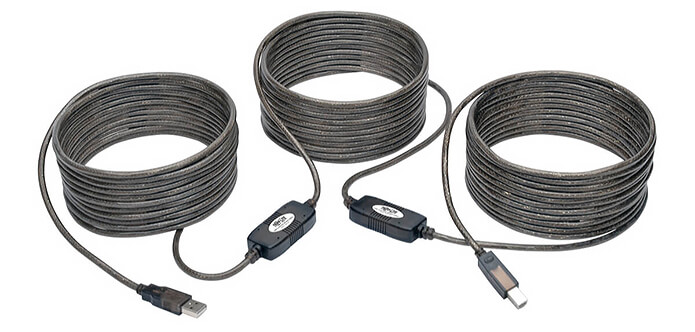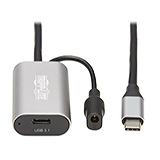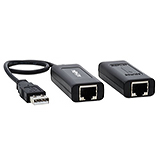All USB cables have a maximum length, but the good news is a variety of cables and extenders are available that allow you to reach much longer distances without signal loss. USB max length

We’ll explain more in a minute, but if you want to know how long your USB cable can reach, the following table is a good starting point. longest Usb cable
USB Standards, Speeds and Cable Length Limits:
| USB Specification | Max. Data Transfer Rate | Recommended Cable Length | |
|---|---|---|---|
| USB 1.0 (Full Speed) | 12 Mb/s | 3 m (9 ft.) | |
| USB 2.0 (High Speed) | 480 Mb/s | 5 m (16 ft.) | Shop USB 2.0 Cables |
| USB 3.2 Gen 1 | 5 Gb/s | 2-3 m (6-9 ft.) | Shop USB 3.0 Cables |
| USB 3.2 Gen 2 | 10 Gb/s | 3 m (9 ft.) | |
| USB 3.2 Gen 2x2 (USB-C only) | 20 Gb/s | 3 m (9 ft.) | |
| USB4 (USB-C only) | 40 Gb/s | 0.8 m (31 ins) |
The USB standard was originally intended to connect desktop computers to peripherals such as printers, mice, keyboards and storage devices. The distance between devices was typically short. Fast forward to the present and USB cables have found applications well beyond the desktop.
For example, it’s not uncommon for the USB‑C port on a laptop to be connected to a wall-mounted display 30-feet away, or a camera in a hallway to be connected to a computer inside an office. You can now lengthen USB connections with select cables and extenders. Let’s take a closer look at USB cable length limits, the technology, and how to extend a USB connection without losing signal strength.
Why do USB Cables Have a Maximum Length?
Most communication protocols used to transfer data between computers and other devices use a signaling method called duplex, including Ethernet and USB. Devices connected in a duplex system can communicate with each other in both directions. So when a USB host sends a “packet” of data to a device connected by a USB cable, it waits for a response before sending the next packet. If no response is received, it tries sending the packet again.
Clearly, timing is very important. As the data transfer rate goes up, the USB host has less time to transmit its data packets and receive a response. The further the signal has to travel, the more likely that an error called a “late collision” will occur, so high data transfer rates typically require a shorter cable. USB cable length limit
Is USB Half-Duplex or Full-Duplex?
USB 3.x (SuperSpeed) is full-duplex, meaning it can send and receive data simultaneously. USB 1.0 and 2.0 are half-duplex (they can transfer and receive data, but not at the same time). To get the benefit of the faster full-duplex communication, both host and connected devices must be USB 3.0 or higher.
The Conductivity of Copper Cabling
Another factor that limits USB max length is the conductivity of copper itself. As a signal travels down a copper wire, it loses some of its strength. The amount of signal loss, referred to as attenuation, is measured in decibels (dB) per foot or meter. The further a signal has to travel, the greater the signal loss until it reaches the point where the receiver is unable to detect or understand the signal. Signal degradation can be reduced by using a well-insulated, larger gauge USB cable.
Copper cabling is also susceptible to noise. For example, running cable too close to light fixtures or electrical power lines can introduce noise into the signal, which affects the quality of the signal rather than its strength. Communication protocols like USB include strategies for mitigating the effects of signal distortion. how long can a USB cable be
4 Ways to Beat USB Cable Length Limitations
Here are four ways to extend USB cable lengths without losing signal strength or quality.
- Buy a Passive USB Cable
A passive cable is a simple cable assembly with a USB connector at each end. No attempt is made to boost or regenerate the signal so passive cables are susceptible to the problems of attenuation and noise described above. However, buying a good quality cable with thicker gauge copper conductors and better shielding will allow you to modestly extend signal transmission beyond the recommended maximum distance.
- Consider an Active USB Cable
Active cables include circuitry, usually at the receiving end, that regenerates the signal and enables data to be transmitted over longer distances. Active cables are typically “bus powered” but longer cables may come with the option of an external AC adapter or USB‑A connector to ensure that the signal booster has adequate power. Active cables can be daisy-chained so long as power is available for each transceiver in the chain.

- Achieve Longer Distances with USB over Cat5/Cat6 Extenders
A USB over Cat5/Cat6 extender is really a one port hub. It converts the USB signal into Ethernet, transmits it over regular category cable, and converts it back to USB on the far end. Most USB extenders can transmit data up to 164 feet without signal loss. This should not be confused with a USB network adapter, which allows a USB port to connect to an Ethernet network.

- Go the Distance with USB over Fiber Extenders
USB over fiber extenders allow you to Install your USB devices anywhere and is the ultimate choice for maximum distance. Most USB over fiber extenders support all major operating systems including Windows, Mac OS, and Linux. These extenders are an ideal choice for a wide variety of USB devices, including printers, scanners, hard drives, audio devices, touch screens, and Web cams that require long distances from your laptop or PC.





